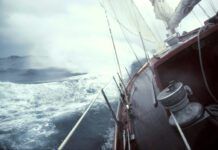What’s important about good sail shape? As one sailmaker likes to explain it, using poorly shaped or blown-out sails is like driving on bald tires. You’re pretty sure your car will take you from A to B, but you won’t be able to turn well or stop promptly, and your enjoyment of driving will be diminished.
Before wading into these complex waters, it’s good to know some essential terminology and understand a few basic concepts involved in sailmaking, so here’s a quick primer.
Upwind sails are characteristically built in two ways, either by crosscut or composite construction (often referred to as laminated sails). Crosscut sails are essentially built of woven polyester fabric (most often know by DuPont’s trademarked name, Dacron) where the panels of cloth run from the luff of the sail to the leech. Composite construction can be achieved in several ways, but the objective is to align the load-bearing fibers of the main structural material (often referred to as the scrim) with the primary load paths of the sail. Doing this requires layering different materials, since mere woven polyester, with its strength primarily in the fill (or short axis) direction of the weave, won’t suffice for more than modest loads and thus isn’t sufficient in composite construction for sails that will be hoisted on boats over 20 feet.
For more advice and recommendations on sails – what to buy, carry and use – purchase Practical Sailor’s ebook Sail Buying, Sail Making, & Mainsails.
Also, check out the complete 3 volume series, A Look at Sails at a price that’s like getting one ebook free when you buy the other two.










































